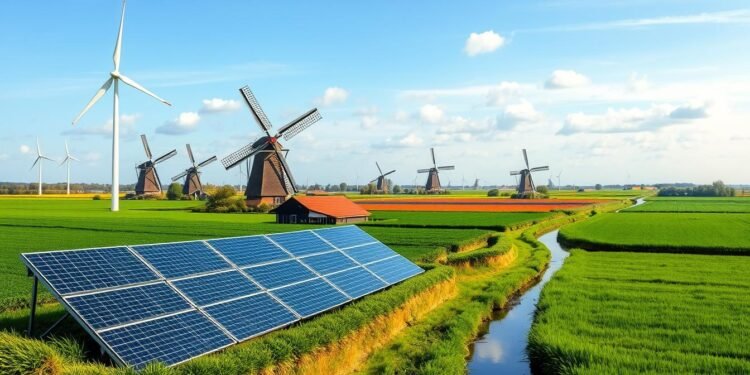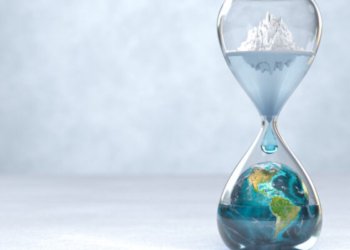The Dutch government has a big plan for a sustainable future. They follow the United Nations’ 17 Sustainable Development Goals (SDGs). These goals aim to make the world better for everyone by 2030.
The Dutch climate action plan tackles many issues. It covers everything from fighting poverty to protecting the environment. The government is working hard to achieve these goals at home and abroad.
One important part is linking foreign trade with development help. This way, the Netherlands supports other countries in becoming more sustainable. The government has promised a lot of money to fight climate change in developing nations.
While progress is seen in areas like work, education, and health, there are challenges. The Netherlands is struggling to meet some environmental and climate goals. The government checks its progress and shares yearly reports to see how close they are to the SDGs.
Key Takeaways
- The Netherlands adopted 17 UN Sustainable Development Goals
- Dutch environmental initiatives focus on both domestic and international efforts
- The government combines foreign trade with development cooperation
- Progress is tracked through annual reports and assessments
- Challenges remain in meeting environmental and climate-related goals
- Significant funds are allocated to support climate action in developing countries
Overview of Sustainable Development in the Netherlands
The Netherlands is leading the way in sustainable development. This small country has big dreams for a greener future. They’ve been working hard to meet global goals for a better world.
Definition and Importance
In the Netherlands, sustainable development means growing the economy and protecting nature. They focus on clean energy, fighting climate change, and saving plants and animals. Their goal is to balance today’s needs with tomorrow’s well-being.
Historical Context
The Netherlands has a long history of managing its environment, like water. Now, they face new challenges. They’re working on 17 global goals to improve life for everyone.
Dutch companies, schools, and people are all helping out. Over 500 groups have made promises to help reach these goals. The government checks progress every year and shares the results. While they’re doing well in some areas, there’s more work to do.
Key Sustainable Development Goals
In 2015, the United Nations set 17 Sustainable Development Goals for 2030. The Netherlands has adopted these goals. It aims to make its policies more sustainable, following global standards.
Aligning Policies with Global Standards
In February 2021, a report showed the Netherlands is making good progress. It leads in reducing poverty, growing its economy, and innovating. Dutch policies are designed to include these goals in local governance.
The Central Bureau of Statistics (CBS) tracks the Netherlands’ progress every year. This helps in making better policies. A dashboard system helps monitor progress in each goal.
Local Implementation Examples
More Dutch municipalities are working on sustainable development goals. Eighty have joined the Global Goals Municipality Campaign. Cities like Utrecht use these goals to guide their policies.
Dutch cities like Oss, Utrecht, and Rheden share their success stories. These examples show how local efforts can help achieve the goals by 2030. Community involvement is key to reaching global sustainability targets.
Renewable Energy Initiatives
The Netherlands is leading the way in renewable energy. The goal is to use almost 100% sustainable energy by 2050. This push is focusing on wind and solar energy.
Wind Energy Projects
Wind energy is a big part of the Netherlands’ plan. They aim to boost wind power to over 20 gigawatts by 2030. This is a big increase from the current 5 gigawatts.
Offshore wind farms are a key part of this plan. They use the country’s coastline to their advantage.
Solar Energy Expansion
Solar energy is also important in the Netherlands’ transition. The country is growing its solar capacity fast. This includes homes and businesses.
Government support, like the Renewable Energy Grant Scheme, helps this growth. It makes solar energy more affordable.
Now, about 16-17% of the country’s energy comes from renewables. Last year, 50% of electricity was from green sources. The government wants to keep increasing these numbers.
They aim for 14% sustainable energy by 2020 and 16% by 2023. These efforts are cutting carbon emissions and creating jobs. They’re also helping the economy in the renewable sector.
Circular Economy Strategies
The Netherlands is at the forefront of circular economy efforts. It aims to reduce primary raw material use by 50% by 2030. This shows a strong commitment to sustainable practices and efficient use of resources.
Waste Reduction Programs
Dutch waste management strategies emphasize shared responsibility. Producers and importers must take care of product waste. This encourages companies to make more sustainable products and increase recycling.
The construction sector, which uses 50% of raw materials, is a major focus. These programs aim to make it more sustainable.
Business Innovations
Eco-innovation programs are changing Dutch businesses. The government supports circular design, promoting products that are easy to repair and reuse. By 2022, manufacturing companies are expected to adopt these practices.
Market incentives help this transition. They reward companies that use resources wisely.
Public procurement is key in these circular economy efforts. The government wants to save 1 megaton of CO2 through circular purchasing. Agencies like Rijkswaterstaat are testing reusable components in infrastructure projects.
The Ministry of Defence now uses recycled parts in equipment manufacturing. These strategies aim to create economic opportunities, reduce reliance on scarce imports, and protect the environment. The Netherlands is leading in sustainable development, shaping EU policies on the circular economy.
Sustainable Transportation Policies
The Netherlands is a leader in green transport. It aims to lower carbon emissions and encourage eco-friendly travel. The goal is to cut CO2 emissions by 49% by 2030 compared to 1990 levels.
Electric Vehicle Incentives
Electric cars are key in Dutch transport plans. In 2020, 21% of new cars were electric. The Netherlands has a lot of public charging stations.
Amsterdam gives up to €3,000 for zero-emission taxis and €40,000 for clean vans and trucks. These deals make electric cars as cheap as gas cars.
Public Transport Enhancements
The Netherlands is making public transport greener. All electric trains run on green energy from 2017. By 2025, all buses will use 100% renewable energy.
By 2030, all buses must be emission-free. The goal is to make travel between major cities under an hour by 2040. Smart apps help find the best travel options.
These efforts show the Dutch dedication to green transport. Electric cars and better public transport are making travel cleaner and more efficient for everyone.
Green Urban Planning
The Netherlands is a leader in green urban planning. It creates eco-friendly cities that focus on sustainability. Dutch cities are becoming green havens, combining innovative design with nature.
Creating Eco-Friendly Cities
Sustainable cities in the Netherlands use nature-based solutions. The Naturvation Project is a 4-year effort by 14 European institutions. It aims to change urban development with green spaces.
Dutch policymakers support nature-based solutions in cities. These efforts improve public health and reduce pollution. The ‘Green-in-and-around cities’ policy helps add green spaces to urban planning.
Promoting Green Spaces
Cities like Amsterdam and Rotterdam are leading in nature-inclusive urban development. They create green spaces for both the environment and people. The Dutch government wants to cut greenhouse gas emissions by 55% by 2030.
Local and regional governments are key in protecting nature for sustainable cities. Working together is essential for green urban planning. This teamwork helps Dutch cities stay sustainable and livable.
Environmental Protection Regulations
The Netherlands is serious about protecting the environment. The Dutch government has strict rules to keep nature safe and fight pollution. They work hard to save biodiversity and keep air and water clean.
Biodiversity Conservation Efforts
The Dutch government is dedicated to saving biodiversity. They protect meadow birds and encourage eco-friendly farming. They also plan to double their budget for tropical rainforest conservation.
The Cartagena Protocol helps manage genetically modified organisms safely. This protects our ecosystems.
Air and Water Quality Standards
The Netherlands follows strict air and water quality rules. They join international agreements like the Rotterdam and Stockholm Conventions. These agreements control hazardous chemicals and ban harmful pesticides.
The country also follows EU directives like REACH. This monitors chemicals in the market. By 2030, they aim to cut carbon emissions by 60% to improve air quality.
The Netherlands’ environmental efforts extend beyond its borders. They aim to give renewable energy to 100 million people in developing countries by 2030. They also increase climate finance to €1.8 billion by 2025 to help vulnerable populations.
These actions show the Netherlands’ strong commitment to global environmental health and sustainability.
Climate Change Mitigation Goals
The Netherlands has set big goals to fight climate change. These goals aim to cut down greenhouse gas emissions and reach carbon neutrality. The country shows its commitment through the National Climate Agreement and various initiatives.
National Climate Agreement
The National Climate Agreement is key to Dutch climate policy. It involves sectors like electricity, industry, and transport. The goal is to cut greenhouse gas emissions by 49% by 2030, compared to 1990 levels.
This target is higher than what Europe aims for. It shows the Netherlands’ strong commitment to reducing emissions.
Focus on Carbon Neutrality
The Dutch government wants to be carbon neutral by 2050. By then, they aim to cut emissions by 95% from 1990 levels. The Climate Act also plans for 100% CO2-neutral electricity by 2050.
To reach these goals, the Netherlands is investing in clean energy. They’re also making buildings more energy-efficient and planting more trees to absorb CO2.
The Dutch policy focuses on smart, clean, and efficient technologies. Through Green Deals, the government supports climate-friendly innovations. Despite challenges, the Netherlands is determined to lead in sustainability and carbon neutrality.
Sustainable Agriculture Practices
Dutch farming leads in sustainable agriculture. The Netherlands has 66% of its land for farming. It exports €65 billion in produce every year. This shows how big a role farming plays in the Dutch economy.
Organic Farming Support
The Dutch government supports organic farming a lot. They want to grow organic sales by 10%. They work with supermarkets and farming groups to make this happen. This shows their dedication to green farming.
Reducing Chemical Use
Using less chemicals is a big goal in Dutch farming. The government pushes for safe farming methods. Farmers are only allowed to use chemicals when it’s really needed.
By 2030, the Netherlands plans to use 30% less fossil materials. They want to use more green materials. This includes research into new ways to use biomass, like green gas and bio-plastics.
Public Engagement and Awareness
The Netherlands is leading the way in public engagement and sustainability awareness. Dutch citizens are key in shaping the country’s green future. Educational campaigns and community programs are essential to this effort.
Educational Campaigns
The Dutch government is running educational campaigns to boost sustainability awareness. These campaigns reach schools, businesses, and the public. They teach about reducing energy use and waste.
For instance, campaigns show that households account for 12% of total energy use in the Netherlands.
Community Involvement Programs
Community involvement is critical for sustainable development. The Netherlands has launched several programs to encourage public participation. The SDG Charter is one such initiative.
This platform brings together over 500 Dutch organizations committed to sustainable goals. These groups work together to create positive change in their communities.
Public engagement has led to real policy shifts. In response to citizen concerns, the government now aims for a 55% CO2 reduction. This goal is more ambitious than the previous 49% target.
Local actions, like reducing plastic use or choosing green transport, make a big difference. By working together, Dutch citizens are building a more sustainable future.
Role of Technology in Sustainability
The Netherlands is leading the way in making our future greener. They use sustainability technology to build smart cities and push research forward. The goal is to have almost all energy from sustainable sources by 2050. They also want to cut CO2 emissions by 80% to 95% from 1990 levels.
Smart City Innovations
Dutch cities are getting smarter to make life better and protect the environment. They have efficient public transport, energy-saving lights, and better waste management. The Netherlands is also focusing on renewable energy like geothermal and solar to power these smart cities.
Research and Development Initiatives
The Dutch government backs research in sustainability tech with grants and tax breaks. Programs like the Renewable Energy Grant Scheme (SDE+) and Energy Investment Tax Credit help green businesses grow. This has made energy a big part of the Dutch economy, creating jobs and boosting competitiveness.
Statistics Netherlands (CBS) is key in tracking progress towards Sustainable Development Goals. They’ve grown data coverage of SDG indicators from 37% to 51% in six years. This shows the Netherlands’ dedication to using tech for a sustainable future.
Future Directions for Sustainable Policies
The Dutch government started its journey towards sustainability in 2000 with the fourth National Environmental Policy Plan (NMP4). This plan looked 30 years ahead, unlike the usual four-year plans. It identified seven major environmental challenges and barriers to sustainability, setting the stage for new solutions.
Challenges Ahead
Despite progress, the Netherlands faces challenges in achieving all Sustainable Development Goals by 2030. Environmental goals and gender equality are major concerns. The country must balance economic growth with environmental protection, a task that requires ongoing innovation and policy updates.
The government’s modified development policy aims to tackle these issues head-on. It focuses on combining foreign trade and development cooperation.
Vision for 2030 and Beyond
The Dutch vision for 2030 and beyond is ambitious. Building on initiatives like the DTO program launched in 1993 and the KETI group formed in 1999, the Netherlands aims to foster system innovation and interdepartmental cooperation. Increased investment in climate policy, global health, and humanitarian aid are key to this vision.
As the country continues to evolve its approach, the focus remains on creating a more sustainable future. This will be achieved through innovative technologies and collaborative governance.
FAQ
What are the main Sustainable Development Goals adopted by the Dutch government?
The Dutch government has set 17 Sustainable Development Goals (SDGs) for 2030. These goals aim to make the world sustainable for everyone. They cover issues like poverty, environmental protection, and economic growth.
The Netherlands focuses on climate action, sustainable cities, and responsible consumption. It also works on biodiversity.
How is the Netherlands addressing renewable energy challenges?
The Netherlands is tackling its low renewable energy rate by investing in wind and solar energy. It aims to reduce industry energy use and promote green innovations.
What circular economy strategies is the Netherlands implementing?
The Netherlands is working on a circular economy to reduce waste. It promotes sustainable production and consumption. This includes waste reduction and business innovations in bio-based economy and electric transport.
It also focuses on tackling food and hazardous waste.
How is the Dutch government promoting sustainable transportation?
The Dutch government supports electric vehicles and public transport. It invests in electric vehicle infrastructure and improves public transport systems.
What efforts is the Netherlands making in green urban planning?
The Netherlands is planning eco-friendly cities through green urban planning. It has 12 priorities for sustainable urban development. These include improving air quality and climate adaptation.
It also focuses on nature-based solutions in cities.
What are the Netherlands’ climate change mitigation goals?
The Netherlands aims to reduce greenhouse gas emissions and achieve carbon neutrality. It has a National Climate Agreement and invests in climate action.
Despite challenges, the country works to lower emissions and use less fossil fuels.
How is the Netherlands promoting sustainable agriculture practices?
The Dutch government supports organic farming and reduces chemical use in agriculture. It promotes organic farming and researches sustainable agriculture methods.
This includes permaculture and environmentally friendly farming.
What role does technology play in Dutch sustainability efforts?
The Netherlands uses technology for sustainability through smart city innovations. It promotes sustainable innovation and invests in green technologies.
This includes the circular economy and electric transport.
What challenges does the Netherlands face in achieving its sustainability goals?
The Netherlands faces challenges in achieving SDGs, mainly in environmental goals and gender equality. It works to address these by modifying its policy and increasing climate policy investment.
The country also focuses on global health and humanitarian aid.





